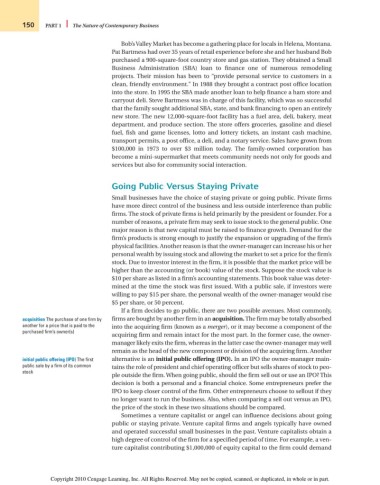Page 176 - Introduction to Business
P. 176
150 PART 1 The Nature of Contemporary Business
Bob’s Valley Market has become a gathering place for locals in Helena, Montana.
Pat Bartmess had over 35 years of retail experience before she and her husband Bob
purchased a 900-square-foot country store and gas station. They obtained a Small
Business Administration (SBA) loan to finance one of numerous remodeling
projects. Their mission has been to “provide personal service to customers in a
clean, friendly environment.” In 1988 they brought a contract post office location
into the store. In 1995 the SBA made another loan to help finance a ham store and
carryout deli. Steve Bartmess was in charge of this facility, which was so successful
that the family sought additional SBA, state, and bank financing to open an entirely
new store. The new 12,000-square-foot facility has a fuel area, deli, bakery, meat
department, and produce section. The store offers groceries, gasoline and diesel
fuel, fish and game licenses, lotto and lottery tickets, an instant cash machine,
transport permits, a post office, a deli, and a notary service. Sales have grown from
$100,000 in 1973 to over $3 million today. The family-owned corporation has
become a mini-supermarket that meets community needs not only for goods and
services but also for community social interaction.
Going Public Versus Staying Private
Small businesses have the choice of staying private or going public. Private firms
have more direct control of the business and less outside interference than public
firms. The stock of private firms is held primarily by the president or founder. For a
number of reasons, a private firm may seek to issue stock to the general public. One
major reason is that new capital must be raised to finance growth. Demand for the
firm’s products is strong enough to justify the expansion or upgrading of the firm’s
physical facilities. Another reason is that the owner-manager can increase his or her
personal wealth by issuing stock and allowing the market to set a price for the firm’s
stock. Due to investor interest in the firm, it is possible that the market price will be
higher than the accounting (or book) value of the stock. Suppose the stock value is
$10 per share as listed in a firm’s accounting statements. This book value was deter-
mined at the time the stock was first issued. With a public sale, if investors were
willing to pay $15 per share, the personal wealth of the owner-manager would rise
$5 per share, or 50 percent.
If a firm decides to go public, there are two possible avenues. Most commonly,
acquisition The purchase of one firm by firms are bought by another firm in an acquisition.The firm may be totally absorbed
another for a price that is paid to the into the acquiring firm (known as a merger), or it may become a component of the
purchased firm’s owner(s)
acquiring firm and remain intact for the most part. In the former case, the owner-
manager likely exits the firm, whereas in the latter case the owner-manager may well
remain as the head of the new component or division of the acquiring firm. Another
initial public offering (IPO) The first alternative is an initial public offering (IPO). In an IPO the owner-manager main-
public sale by a firm of its common tains the role of president and chief operating officer but sells shares of stock to peo-
stock
ple outside the firm. When going public, should the firm sell out or use an IPO? This
decision is both a personal and a financial choice. Some entrepreneurs prefer the
IPO to keep closer control of the firm. Other entrepreneurs choose to sellout if they
no longer want to run the business. Also, when comparing a sell out versus an IPO,
the price of the stock in these two situations should be compared.
Sometimes a venture capitalist or angel can influence decisions about going
public or staying private. Venture capital firms and angels typically have owned
and operated successful small businesses in the past. Venture capitalists obtain a
high degree of control of the firm for a specified period of time. For example, a ven-
ture capitalist contributing $1,000,000 of equity capital to the firm could demand
Copyright 2010 Cengage Learning, Inc. All Rights Reserved. May not be copied, scanned, or duplicated, in whole or in part.

